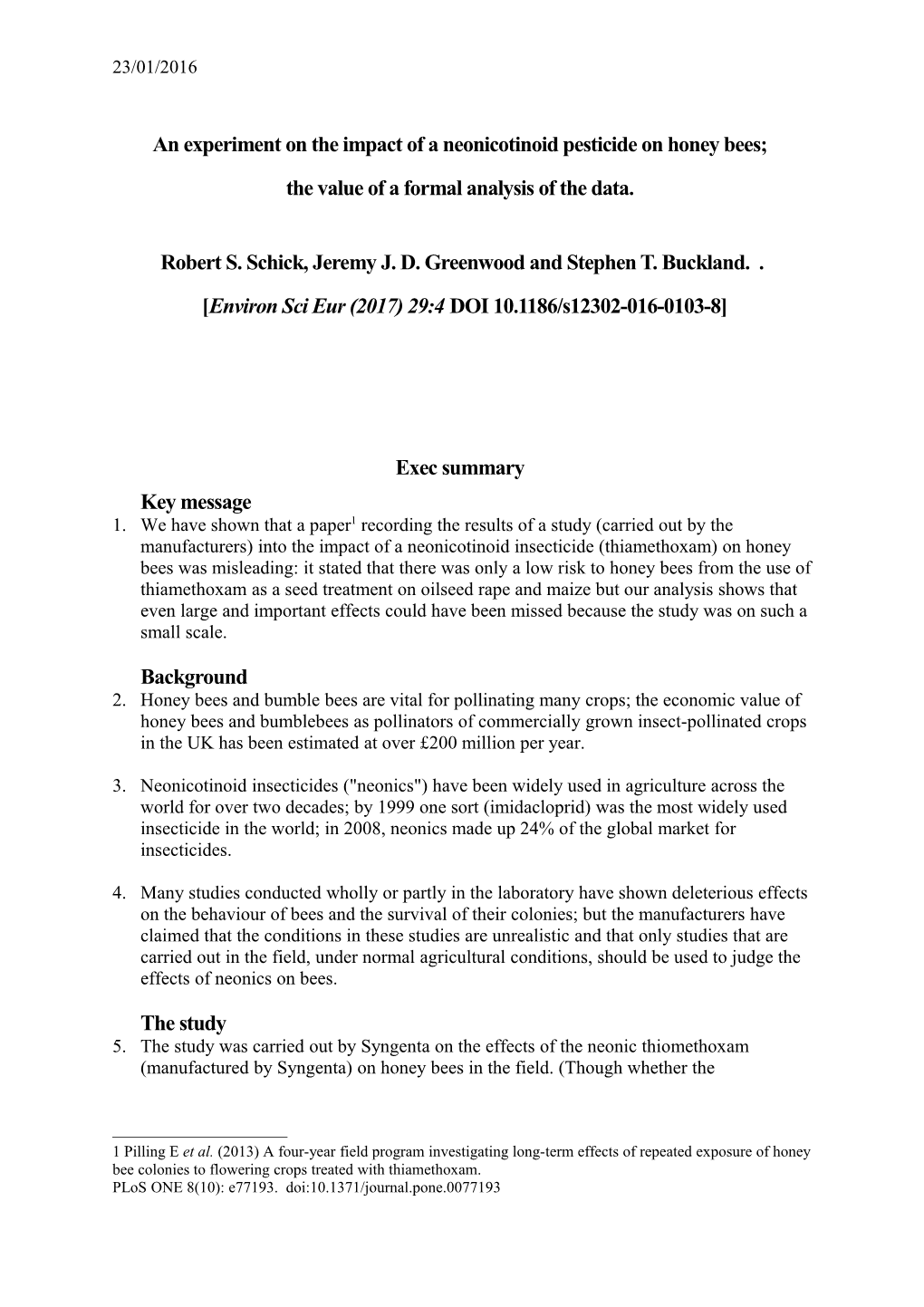23/01/2016
An experiment on the impact of a neonicotinoid pesticide on honey bees;
the value of a formal analysis of the data.
Robert S. Schick, Jeremy J. D. Greenwood and Stephen T. Buckland. .
[Environ Sci Eur (2017) 29:4 DOI 10.1186/s12302-016-0103-8]
Exec summary
Key message
- We have shown that a paper[1] recording the results of a study (carried out by the manufacturers) into the impact of a neonicotinoid insecticide (thiamethoxam) on honey bees was misleading: it stated that there was only a low risk to honey bees from the use of thiamethoxam as a seed treatment on oilseed rape and maize but our analysis shows that even large and important effects could have been missed because the study was on such a small scale.
Background
- Honey bees and bumble bees are vital for pollinating many crops; the economic value of honey bees and bumblebees as pollinators of commercially grown insect-pollinated crops in the UK has been estimated at over £200 million per year.
- Neonicotinoid insecticides ("neonics") have been widely used in agriculture across the world for over two decades; by 1999 one sort (imidacloprid) was the most widely used insecticide in the world; in 2008, neonics made up 24% of the global market for insecticides.
- Many studies conducted wholly or partly in the laboratory have shown deleterious effects on the behaviour of bees and the survival of their colonies; but the manufacturers have claimed that the conditions in these studies are unrealistic and that only studies that are carried out in the field, under normal agricultural conditions, should be used to judge the effects of neonics on bees.
The study
- The study was carried out by Syngenta on the effects of the neonic thiomethoxam (manufactured by Syngenta) on honey bees in the field. (Though whether the experimental protocol was close enough to normal agricultural conditions to be relevant has been questioned[2]
- Two experiments were conducted. One used oilseed rape, the other used maize.
- The oilseed rape experiment was conducted at two locations, the maize at three.
- At each location the experiments used pairs of fields; in one field the crop was treated with thiamethoxam at levels normally used by farmers; in the other field the crop was untreated (the control).
Interpretation of the results by the authors of the study
- The authors of the study stated that because the experiments involved so little replication (two cases for oilseed rape and three for maize) a formal analysis of the data "would lack the power to detect anything other than very large treatment effects, and it is clear from a simple inspection of the results that no large treatment effects were present. Therefore a formal statistical analysis was not conducted because this would be potentially misleading."
- This approach is fundamentally wrong in two respects: (1) formal statistical analysis is only potentially misleading if one uses the wrong method and (2) inspection of the results is always potentially misleading because it is an entirely subjective procedure.
Formal analysis: incorrect
- An analysis of the data from the Syngenta study that was restricted merely to tests of statistical significance would show that there were very few significant differences in the performance of bees exposed to treated or control crops.
- A lack of significance is often taken to mean that there is no difference but this is an incorrect inference. While it is true that an insignificant result could mean that there is no effect, it could also mean that there was an effect but the experiment was insufficiently powerful to reveal it. Thus an analysis restricted to significance tests and which employed the incorrect inference of "no significance means no effect" would, indeed, be misleading. It is impossible to judge the size of the effect from a significance test alone.
Formal analysis: correct
- The correct approach is to estimate the size of the effect and calculate the confidence limits of that estimate. That is what we did.
- The analysis showed that the confidence limits of the estimates of the effects of thiomethoxam in the Syngenta study were mostly too wide to reveal anything useful: it was impossible to rule out either the possibility that the effects were trivial or the possibility that they were large enough to be ecologically or economically important.
[1] Pilling E et al. (2013) A four-year field program investigating long-term effects of repeated exposure of honey bee colonies to flowering crops treated with thiamethoxam.
PLoS ONE 8(10): e77193. doi:10.1371/journal.pone.0077193
[2] Hoppe P P et al. (2015) Effects of a neonicotinoid pesticide on honey bee colonies: a response to the field
study by Pilling et al. (2013). Environ Sci Eur 27:28. doi:10.1186/s12302-015-0060-7
